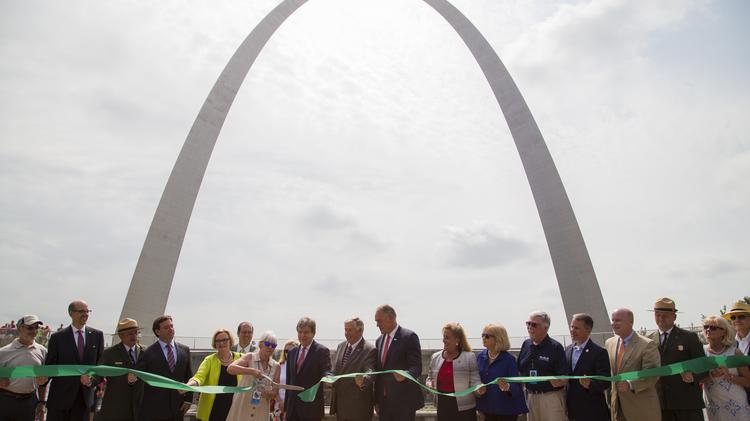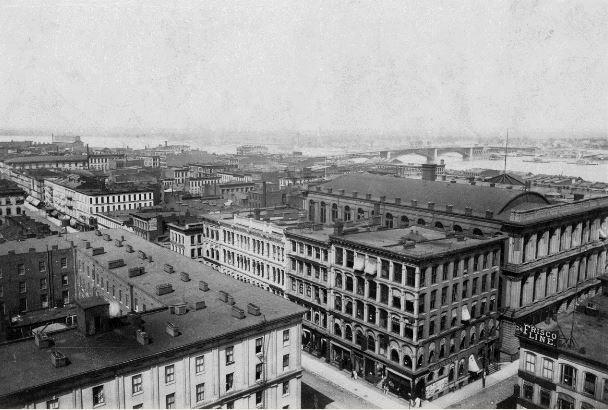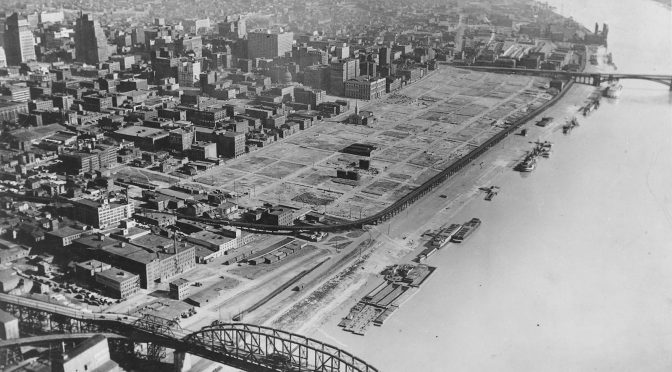by Randall Hill
On July 3, 2018, a ribbon-cutting ceremony for the renovated St. Louis Gateway Arch grounds was held. The history of the Arch is rooted in exclusion and racist policy. Black businesses were evicted to make room for the Arch and blacks were denied employment opportunities during the Arch construction. 53 years later, blacks were not represented in the ribbon cutting ceremony although the City of St. Louis has a majority black population.

The photo above is symbolic of how black people are constantly being removed for the benefit of others. The City of St. Louis removed blacks from the riverfront, sections of downtown including the Mill Creek Valley to build Pruitt Igoe.

The Mill Creek area was supposedly blighted, however, my father, who will be 90 later this year, told me many of the residents of Mill Creek were homeowners who took pride in their homes and kept them up. When I saw pictures of Mill Creek Valley, it looked very similar to the Soulard and Lafayette square neighborhoods. 
In 1959, demolition of the neighborhood began, displacing over 20,000 residents, 95% of whom were black. Keep in mind, during this time the federal government was still actively redlining and withholding funds to improve black neighborhoods. Of the $120 billion worth of new housing subsidized by the government between 1934 and 1962, less than 2 percent went to nonwhite families.

The Interstate highways wiped out many predominantly black neighborhoods and turned them into surface parking and highways or isolated them contributing to their failure. Even the Cookie Thornton shooting was related to black removal. Most recently, the false promises of Paul McKee and the NGA project resulted in the further displacement of black families and neighborhoods all under the guise of urban renewal. James Baldwin pointed out in a 1963 interview that, "urban renewal..means negro removal".
People of African descent have played a large role in St. Louis since the city’s founding in 1764. Downtown St. Louis was a center of black cultural, economic, political, and legal achievements that have shaped not only the city but the nation as well. Early census figures show blacks, both free and slave, lived in St. Louis from its earliest days under French and Spanish colonial rule. By the 1820 census, 10,000 slaves lived in Missouri, about one-fifth of the state’s population, however only 347 "free colored persons" lived in Missouri. That same year, the Missouri Compromise admitted Missouri to the Union as a slave state. Evidence of black life in downtown St. Louis has been erased from the City's landscape and memory. See: "African Americans in Downtown St. Louis".
In 1935 St. Louis approved a bond issue for a project commemorating Jefferson’s Louisiana Purchase and to clear an area of empty, “blighted” warehouses. A study by the Post-Dispatch at the time of the 1935 vote found the riverfront wasn’t a derelict district that needed to be cleared. The paper found 290 active businesses and a 2% vacancy rate on 37 blocks that would become the Arch.

As Tony Messenger pointed out in his article, "Krewson's deputy mayor calls all-white Arch photo a 'symptom' of St. Louis' racial divide": In 1939, the city of St. Louis began clearing 486 buildings from the area near its riverfront. Most housed businesses owned and run by black St. Louisans. About 5,000 jobs were lost.
Westward Expansion
Let's not forget the original motivation for the St. Louis Arch. It was built to honor St. Louis' role in westward expansion, a time when Manifest Destiny was used to push Native Americans and Mexicans out of their lands. It is estimated 10 million+ Native Americans were living on land that is now the United States when European explorers first arrived in the 15th century. It is estimated that over nine million Native Americans were killed after European settlers arrived.
"Illegal aliens have always been a problem in the United States. Ask any Indian."
As the United States expanded westward, violent conflicts over territory multiplied. In 1784, one British traveler noted:
“White Americans have the most rancorous antipathy to the whole race of Indians; and nothing is more common than to hear them talk of extirpating them totally from the face of the earth, men, women, and children.”
After the American Revolution, many Native American lives were already lost to disease and displacement. In 1830, the federal Indian Removal Act called for the removal of the ‘Five Civilized Tribes’ – the Cherokee, Chickasaw, Choctaw, Creek, and Seminole.
Between 1830 and 1838, federal officials working on behalf of white cotton growers forced nearly 100,000 Indians out of their homeland. The dangerous journey from the southern states to “Indian Territory” in current Oklahoma is referred to as the Trail of Tears. By 1837, 46,000 Native Americans had been removed from their homelands, thereby opening 25 million acres for predominantly European settlement.
Ferguson should have acted as a wake-up call to the entire St. Louis region. This year will mark the fourth anniversary of Michael Brown's death, but the City of St. Louis and the greater St. Louis region are either in denial or indifferent about its exclusionary institutionalized racist and oppressive nature. As Dr. Martin Luther King Jr. aptly stated, “a riot is the language of the unheard".
Considering the history of what the St. Louis Arch commemorates and the history of its construction, the lack of diversity in the ribbon cutting symbolized St. Louis' culture of racism. It's time to start listening to the unheard!

